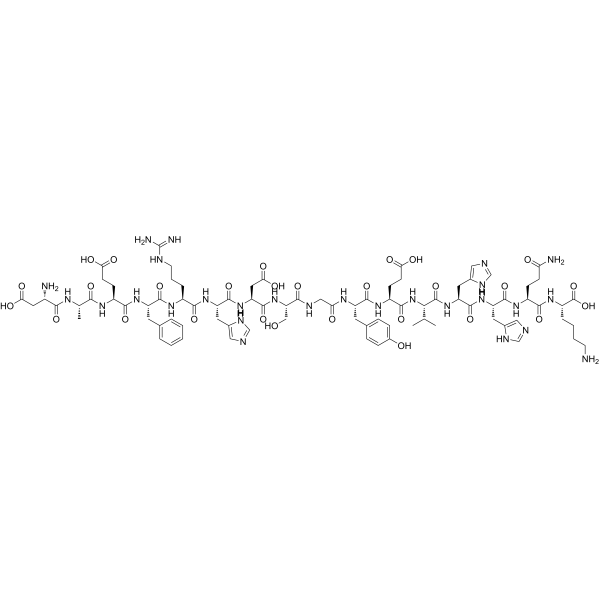产品
编 号:F118514
分子式:C84H119N27O28
分子量:1955.01
分子式:C84H119N27O28
分子量:1955.01
产品类型
规格
价格
是否有货
1mg
询价
询价
5mg
询价
询价
结构图

CAS No: 131580-10-4
产品详情
生物活性:
β-Amyloid (1-16) is a β-Amyloid protein fragment involved in metal binding. Beta-amyloid is a peptide that forms amyloid plaques in the brains of Alzheimer's disease (AD) patients.
体内研究:
β-amyloid (1-16) fragment is considered as valid models to examine the contribution of the key histidine residues (His , His in mouse and His , His , His in human fragments) to the Ab–Cu2+ interaction. Oxidation targets for β-Amyloid (1-16) are the histidine residues coordinated to the metal ions. Copper is bound to Aβ in senile plaque of Alzheimer’s disease with β-Amyloid (1-16) taking part in the coordination of the Cu2+ ions. Cu2+ and Zn2+ are linked with the neurotoxicity of -Amyloid and free radical damage. β-amyloid (1-16) is the minimal amino acidic sequence display a Cu coordination mode which involves three Histidines (His6, His13 and His14). β-amyloid (1-16) is supposed to be involved in metal binding. Human β-amyloid interacts with zinc ions through its metal-binding domain 1-16. The C-tails of the two polypeptide chains of the rat Aβ(1-16) dimer are oriented in opposite directions to each other, which hinders the assembly of rat Aβ dimers into oligomeric aggregates. Thus, the differences in the structure of zinc-binding sites of human and rat β-Amyloid (1-16), their ability to form regular cross-monomer bonds, and the orientation of their hydrophobic C-tails could be responsible for the resistance of rats to Alzheimer's disease.
β-Amyloid (1-16) is a β-Amyloid protein fragment involved in metal binding. Beta-amyloid is a peptide that forms amyloid plaques in the brains of Alzheimer's disease (AD) patients.
体内研究:
β-amyloid (1-16) fragment is considered as valid models to examine the contribution of the key histidine residues (His , His in mouse and His , His , His in human fragments) to the Ab–Cu2+ interaction. Oxidation targets for β-Amyloid (1-16) are the histidine residues coordinated to the metal ions. Copper is bound to Aβ in senile plaque of Alzheimer’s disease with β-Amyloid (1-16) taking part in the coordination of the Cu2+ ions. Cu2+ and Zn2+ are linked with the neurotoxicity of -Amyloid and free radical damage. β-amyloid (1-16) is the minimal amino acidic sequence display a Cu coordination mode which involves three Histidines (His6, His13 and His14). β-amyloid (1-16) is supposed to be involved in metal binding. Human β-amyloid interacts with zinc ions through its metal-binding domain 1-16. The C-tails of the two polypeptide chains of the rat Aβ(1-16) dimer are oriented in opposite directions to each other, which hinders the assembly of rat Aβ dimers into oligomeric aggregates. Thus, the differences in the structure of zinc-binding sites of human and rat β-Amyloid (1-16), their ability to form regular cross-monomer bonds, and the orientation of their hydrophobic C-tails could be responsible for the resistance of rats to Alzheimer's disease.
产品资料

